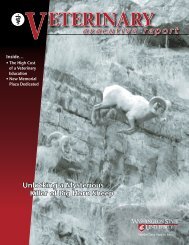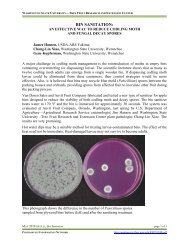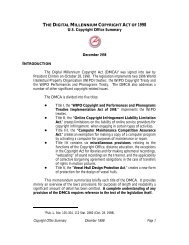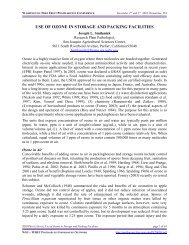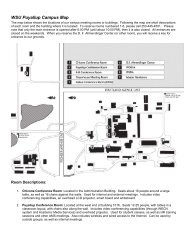Factors Contributing to Lenticel Breakdown (2002) - Postharvest
Factors Contributing to Lenticel Breakdown (2002) - Postharvest
Factors Contributing to Lenticel Breakdown (2002) - Postharvest
- No tags were found...
Create successful ePaper yourself
Turn your PDF publications into a flip-book with our unique Google optimized e-Paper software.
WASHINGTON TREE FRUIT POSTHARVEST CONFERENCEMarch 12 th & 13 th , <strong>2002</strong>, Yakima, WAFACTORS CONTRIBUTING TO LENTICEL BREAKDOWNDr. Eric CurryPlant PhysiologistUSDA, ARS—Tree Fruit Research Labora<strong>to</strong>ryWenatchee, WA 98801CURRY@tfrl.ars.usda.govINTRODUCTIONIn the last year, a number of our research studies have shown certain fac<strong>to</strong>rs are associated withincreased lenticel breakdown in Gala and Fuji apples; other experiments are in progress. Thepurpose of this presentation was <strong>to</strong> present preliminary findings related <strong>to</strong> the occurrence oflenticel breakdown disorder in order <strong>to</strong> formulate and test hypotheses as <strong>to</strong> why some orchardsites are more susceptible than others. This report is a brief summary of the presentation.THE PROBLEM<strong>Lenticel</strong> breakdown (Figure1) has increased in the pastfive years. Generally, thedisorder is unapparent inthe bin before packing.Studies in 2001 weremainly targeted <strong>to</strong>determine what fac<strong>to</strong>rs inthe packing processworsened the symp<strong>to</strong>ms,and what cultural orenvironmental fac<strong>to</strong>rscontributed <strong>to</strong> this problem.PACKAGINGFigure 1. <strong>Lenticel</strong> breakdown on packed Gala.FACTORSFruit from six Gala and six Fuji orchards were taken from bins of commercially harvestedorchards and taken <strong>to</strong> the lab for further evaluation. We conducted tests <strong>to</strong> evaluate the influenceof components in the packing line on lenticel breakdown including: dump tank temperature, soapconcentration, brushes, and waxing. The pro<strong>to</strong>col for the different components in theexperiments was as follows:1. Fruit submerged in deionized water for 10 minutes2. Fruit brushed (actual commercial brushes) with a 1X soap solution for 2 minutes orsubmerged in 1X soap solution (or Tween 20 surfactant) for 2 minutes (no brushes)3. Brushes only for 2 minutes4. Hand waxed with commercial wax using cheesecloth<strong>2002</strong> PROCEEDINGS, <strong>Fac<strong>to</strong>rs</strong> <strong>Contributing</strong> <strong>to</strong> <strong>Lenticel</strong> <strong>Breakdown</strong> page 1 of 4WSU—TFREC POSTHARVEST INFORMATION NETWORKhttp://postharvest.tfrec.wsu.edu/PC<strong>2002</strong>B.pdf
WASHINGTON TREE FRUIT POSTHARVEST CONFERENCEMarch 12 th & 13 th , <strong>2002</strong>, Yakima, WAAll fruit remained at room temperature for 48 hours at which time the number of damaged(brown) lenticels were counted on the entire fruit. With minor exceptions data for Fujiapples was similar <strong>to</strong> that for Gala and will not be shown in this summary.GalaNumber of Damaged <strong>Lenticel</strong>s40035030025020015010050Soap + Wax + BrushesNotTreatedWater BathOnlySoapOnlyWaxOnlyBrushesOnly0Figure 2a. Influence of packing line processes on lenticelbreakdown of Gala prone <strong>to</strong> the disorder.Average Number of Damaged<strong>Lenticel</strong>s per Fruit1009080706050403020GalaSoap + WaxSoap + Wax100NotTreatedBrushesOnly0.1 %Tween10%Tween33FFigure 2b. Influence of packing line processes on lenticelbreakdown of Gala prone <strong>to</strong> the disorder.90FFigures 2a and 2b indicate that the combination of high dump tank temperature, soap, and wax,are most influential in increasing the number of damaged lenticels. My theory as <strong>to</strong> the<strong>2002</strong> PROCEEDINGS, <strong>Fac<strong>to</strong>rs</strong> <strong>Contributing</strong> <strong>to</strong> <strong>Lenticel</strong> <strong>Breakdown</strong> page 2 of 4WSU—TFREC POSTHARVEST INFORMATION NETWORKhttp://postharvest.tfrec.wsu.edu/PC<strong>2002</strong>B.pdf
WASHINGTON TREE FRUIT POSTHARVEST CONFERENCEMarch 12 th & 13 th , <strong>2002</strong>, Yakima, WAmechanism of this injury is as follows. Cold fruit from s<strong>to</strong>rage are placed in warm dump-tankwater (often around 90 ºF). The combination of heat and water causes two things <strong>to</strong> occur: first,the fruit expands, which may cause cracking around the lenticels where cuticle is thin; andsecond, air from inside the fruit bubbles slowly out of the fruit because dissolved oxygen andcarbon dioxide are more soluble in cold water than warm water. When the fruit are treated withsoap, it enters these micro-cracks and destroys the delicate cell membrane of cells beneath thelenticel. This process further enlarges the sub-lenticular cavity, which susceptible fruit alreadyhave developed in the field. When wax is applied, it “seals” the fruit surface, and as fruit return<strong>to</strong> room temperature (or cold-room temperature) the shrinking air in the cavity exerts negativepressure on the cuticle and sucks it down creating a sunken area on the surface.Other experiments using vacuum infiltration of dye in<strong>to</strong> the fruit at harvest indicate that fruit thathave “open” lenticels at harvest are most prone <strong>to</strong> develop the disorder after s<strong>to</strong>rage. Figure 3shows two fruit from different orchards, which were both, vacuum-infiltrated with dye at harvest(<strong>to</strong>p picture).Figure 3. Gala vacuum-infiltrated with dye at harvest (<strong>to</strong>p) andtreated with soap and wax after 6 months cold s<strong>to</strong>rage (bot<strong>to</strong>m).After six months, the same fruit was subjected <strong>to</strong> the experimental pro<strong>to</strong>col described above(warm water bath, soap and wax) and clearly, fruit showing uptake of dye at harvest (openlenticels) developed post-s<strong>to</strong>rage pitting.What fac<strong>to</strong>rs and conditions during fruit growth are responsible for the “open” lenticels?Experiments are underway <strong>to</strong> answer this question.<strong>2002</strong> PROCEEDINGS, <strong>Fac<strong>to</strong>rs</strong> <strong>Contributing</strong> <strong>to</strong> <strong>Lenticel</strong> <strong>Breakdown</strong> page 3 of 4WSU—TFREC POSTHARVEST INFORMATION NETWORKhttp://postharvest.tfrec.wsu.edu/PC<strong>2002</strong>B.pdf
WASHINGTON TREE FRUIT POSTHARVEST CONFERENCEMarch 12 th & 13 th , <strong>2002</strong>, Yakima, WAACKNOWLEDGEMENTSThis research was supported by Washing<strong>to</strong>n State growers with funds distributed by theWashing<strong>to</strong>n Tree Fruit Research Commission. It would not have been possible without thewilling cooperation of a number of warehouses and field staff who are committed <strong>to</strong> solvingproblems faced by the entire industry. I also want <strong>to</strong> thank my technicians, Carol Duplaga, HeidiSwoboda, and Joyce Thompson, without whose superb technical skills would not have made thiswork possible.<strong>2002</strong> PROCEEDINGS, <strong>Fac<strong>to</strong>rs</strong> <strong>Contributing</strong> <strong>to</strong> <strong>Lenticel</strong> <strong>Breakdown</strong> page 4 of 4WSU—TFREC POSTHARVEST INFORMATION NETWORKhttp://postharvest.tfrec.wsu.edu/PC<strong>2002</strong>B.pdf



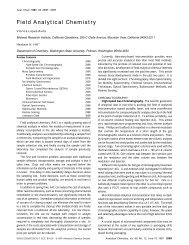
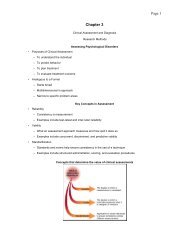
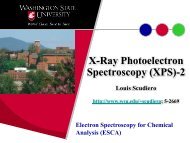
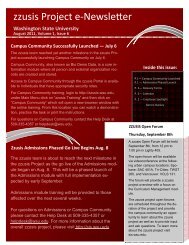
![Graduate School Policies & Procedures Manual 2011 - 2012 [PDF]](https://img.yumpu.com/50747405/1/190x245/graduate-school-policies-procedures-manual-2011-2012-pdf.jpg?quality=85)
